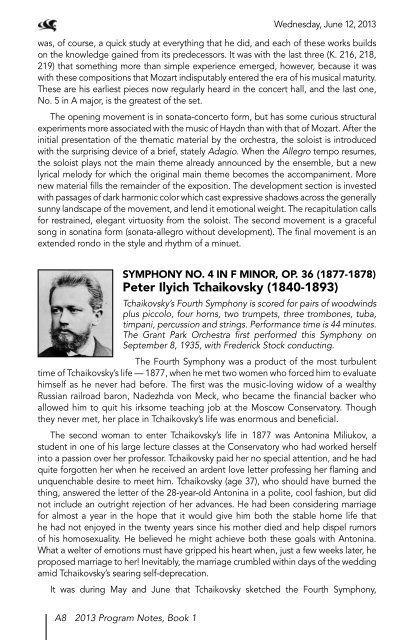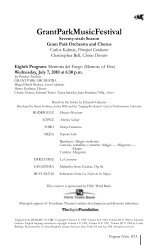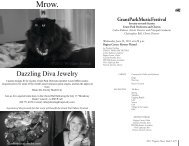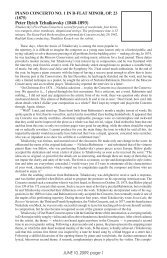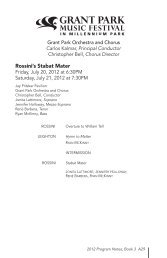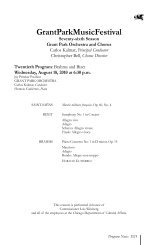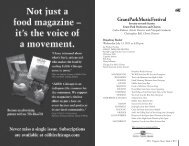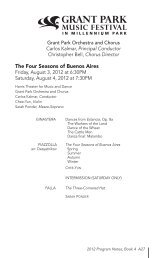Program Notes PDF - The Grant Park Music Festival
Program Notes PDF - The Grant Park Music Festival
Program Notes PDF - The Grant Park Music Festival
Create successful ePaper yourself
Turn your PDF publications into a flip-book with our unique Google optimized e-Paper software.
Wednesday, June 12, 2013<br />
was, of course, a quick study at everything that he did, and each of these works builds<br />
on the knowledge gained from its predecessors. It was with the last three (K. 216, 218,<br />
219) that something more than simple experience emerged, however, because it was<br />
with these compositions that Mozart indisputably entered the era of his musical maturity.<br />
<strong>The</strong>se are his earliest pieces now regularly heard in the concert hall, and the last one,<br />
No. 5 in A major, is the greatest of the set.<br />
<strong>The</strong> opening movement is in sonata-concerto form, but has some curious structural<br />
experiments more associated with the music of Haydn than with that of Mozart. After the<br />
initial presentation of the thematic material by the orchestra, the soloist is introduced<br />
with the surprising device of a brief, stately Adagio. When the Allegro tempo resumes,<br />
the soloist plays not the main theme already announced by the ensemble, but a new<br />
lyrical melody for which the original main theme becomes the accompaniment. More<br />
new material fills the remainder of the exposition. <strong>The</strong> development section is invested<br />
with passages of dark harmonic color which cast expressive shadows across the generally<br />
sunny landscape of the movement, and lend it emotional weight. <strong>The</strong> recapitulation calls<br />
for restrained, elegant virtuosity from the soloist. <strong>The</strong> second movement is a graceful<br />
song in sonatina form (sonata-allegro without development). <strong>The</strong> final movement is an<br />
extended rondo in the style and rhythm of a minuet.<br />
Symphony No. 4 in F minor, Op. 36 (1877-1878)<br />
Peter Ilyich Tchaikovsky (1840-1893)<br />
Tchaikovsky’s Fourth Symphony is scored for pairs of woodwinds<br />
plus piccolo, four horns, two trumpets, three trombones, tuba,<br />
timpani, percussion and strings. Performance time is 44 minutes.<br />
<strong>The</strong> <strong>Grant</strong> <strong>Park</strong> Orchestra first performed this Symphony on<br />
September 8, 1935, with Frederick Stock conducting.<br />
<strong>The</strong> Fourth Symphony was a product of the most turbulent<br />
time of Tchaikovsky’s life — 1877, when he met two women who forced him to evaluate<br />
himself as he never had before. <strong>The</strong> first was the music-loving widow of a wealthy<br />
Russian railroad baron, Nadezhda von Meck, who became the financial backer who<br />
allowed him to quit his irksome teaching job at the Moscow Conservatory. Though<br />
they never met, her place in Tchaikovsky’s life was enormous and beneficial.<br />
<strong>The</strong> second woman to enter Tchaikovsky’s life in 1877 was Antonina Miliukov, a<br />
student in one of his large lecture classes at the Conservatory who had worked herself<br />
into a passion over her professor. Tchaikovsky paid her no special attention, and he had<br />
quite forgotten her when he received an ardent love letter professing her flaming and<br />
unquenchable desire to meet him. Tchaikovsky (age 37), who should have burned the<br />
thing, answered the letter of the 28-year-old Antonina in a polite, cool fashion, but did<br />
not include an outright rejection of her advances. He had been considering marriage<br />
for almost a year in the hope that it would give him both the stable home life that<br />
he had not enjoyed in the twenty years since his mother died and help dispel rumors<br />
of his homosexuality. He believed he might achieve both these goals with Antonina.<br />
What a welter of emotions must have gripped his heart when, just a few weeks later, he<br />
proposed marriage to her! Inevitably, the marriage crumbled within days of the wedding<br />
amid Tchaikovsky’s searing self-deprecation.<br />
It was during May and June that Tchaikovsky sketched the Fourth Symphony,<br />
A8 2013 <strong>Program</strong> <strong>Notes</strong>, Book 1


